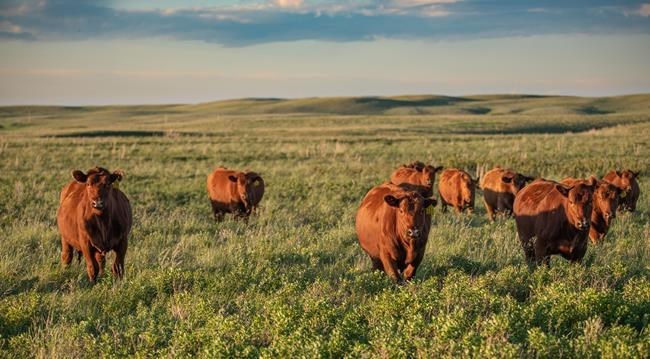LETHBRIDGE, Alta. — An agreement to protect a sprawling ranch in southern Alberta from development is the largest of its kind in the country, the Nature Conservancy of sa���ʴ�ý says, and will allow the family that owns it to continue raising cattle there.
The 22,000-hectare McIntyre Ranch was founded south of Lethbridge, Alta., in 1894 by William McIntyre and it remained in his family until his son, Billy, died in 1947.
A longtime family friend and employee, Ralph Thrall, bought the property after Billy's death and the Thrall family continues to own and operate it today.
"We've just maintained the legacy of sustainable ranching that the McIntyres began when they came up from Texas and saw the overgrazing that had occurred through the Midwest, and so they learned through others' mistakes and left the grass rather than taking it all," Ralph Thrall III said Sunday in a phone interview from Lethbridge.
The agreement, formally announced Monday in recognition of Earth Day, is a partnership between the Thrall family, the Nature Conservancy of sa���ʴ�ý and Ducks Unlimited that gives both organizations conservation easements on the property in perpetuity to prevent it from future development, crop planting, or even wind and solar farms.
In return, Thrall says his family continues to own the property while getting a financial boost for their ranching business.
The Nature Conservancy says McIntyre Ranch contains some of sa���ʴ�ý's most significant uninterrupted blocks of rough fescue grasslands and over 1,000 hectares of wetlands which it says support an abundance of wildlife. It also provides carbon storage and water filtration.
Over 80 per cent of native prairie grasslands in the three Prairie provinces have been lost to other uses, the Conservancy says.
The property is home to over 150 species of birds, mammals, amphibians, reptiles and fish. Recent wildlife surveys have revealed 27 species of concern living there, including ferruginous hawk, chestnut-collared longspur and American badger.
The Conservancy says keeping the land sustainably grazed by cattle is important because their grazing behaviour approximates the historic actions of bison.
“The successful completion of the McIntyre Ranch campaign underscores the power of collaboration and community engagement in conserving sa���ʴ�ý's Prairie grasslands," said Tom Lynch-Staunton, Nature Conservancy of sa���ʴ�ý's regional vice-president.
"We hope this significant milestone is just one of many future achievements in our efforts to safeguard our planet's most endangered ecosystems."
The Nature Conservancy says hundreds of donors made the agreement possible. It says contributions also came from the Government of Alberta through the Alberta Land Trust Grant Program, as well as from the federal government through the Natural Heritage Conservation Program.
The U.S. Fish and Wildlife Service and private contributors also chipped in.
Thrall himself wasn't always interested in ranching. At one point in younger days, he spent a year as a professional golfer. But he says he and his siblings grew up understanding the family's ranch was unique.
He encourages other ranchers interested in protecting their land from development to investigate similar easements.
"If it was about the money, then yeah, we would be selling the ranch and living far more comfortably on the interest from the proceeds," Thrall says.
"That's the price our family is prepared to make for the preservation of something that there isn't very much left of."
This report by The Canadian Press was first published April 22, 2024.
--By Rob Drinkwater in Edmonton
The Canadian Press



